 The 2006 e-consultancy Online Marketing Masterclass event in London was a jam packed day of fantastic speakers, a wonderfully intelligent audience and great conversations. The RIBA is a great location as well, Ashley and the nice e-consultancy team deserve a big round of applause.
The 2006 e-consultancy Online Marketing Masterclass event in London was a jam packed day of fantastic speakers, a wonderfully intelligent audience and great conversations. The RIBA is a great location as well, Ashley and the nice e-consultancy team deserve a big round of applause.
As at all such events there was so much to learn from attending and speaking and from the audience questions. All nine presentations were great but here are two that had I think had particularly relevant insights for readers of Occam’s Razor. I have excerpted the relevant slides, which are followed by a brief commentary that provides my interpretation (a format similar to the emetrics DC summit reflections).
I want to thank the authors for permission to share their work, it is very nice of them to share the wealth.
# 1
Who? Andy Harding, Carphone Warehouse Plc
What? Customer Acquisition in a Multi-Channel Environment ( )
Where? Slides 5 & 6, Customer personas and value of each target. Slide 15, You capability and customer expectations.
Why? I wanted to pick just one thing from each presenter, to keep this blog post short, but there were two absolutely brilliant concepts in Andy’s presentation. Like many of us in the web world The Carphone Warehouse has invested in understanding the personas of their customers:
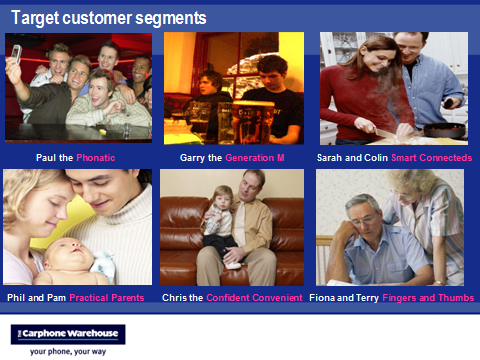
Personas can be used to create optimal customer experiences or to create the right type of marketing programs or targeted acquisitions strategies or other such activities that can be performed when you know your customer so well. But Andy’s team has gone one step further and compute the Size and Value of each persona, here’s the graph plotted with Age on the x-axis….
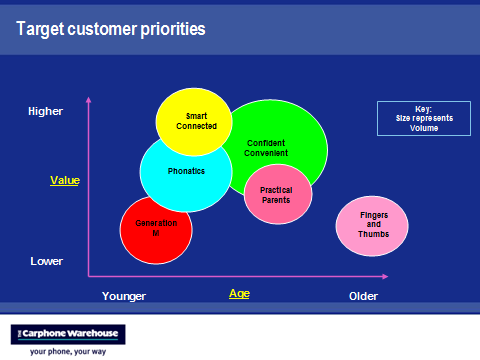
This graph is very powerful because while we all create personas only a select few will take one step further to quantify the value and volume of each of those personas. A graph such as the one above can help provide decision makers with a very powerful mechanism to do simple things like focus on where to invest resources or what the bottom-line impact will be from solving for each persona or, if trended over time, how to improve the value of each of the large bubble and watch it move higher on the y-axis.
I am not sure how Value is computed but you can use Profitability or Customer Loyalty or Net Promoter or Least Likely to Switch (in case of phone company) or Most Amount Spent on Add-on Services or other such metrics. Pick the one that makes most sense for your company.
We are all becoming increasingly familiar that the web is a living breathing mechanism that is constantly changing. For the longest time companies (website owners) were in control of creating the customer experience but increasingly customers are creating their own experiences (think all the web 2.0 stuff and mash-up’s etc).
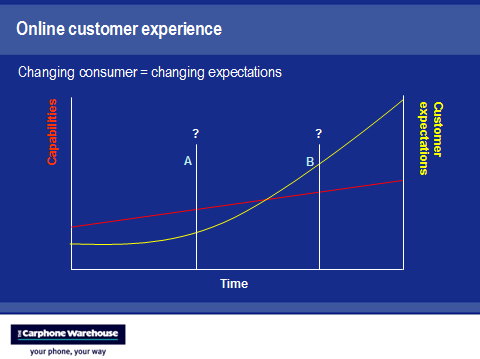
In the above slide Andy provides a great framework to diagnose where we, as website owner’s are, and what the expectations of our customers might be. The red and yellow lines show how capabilities and expectations trend over time.
Early in your existence (or when the Internet started) the red line was lower, websites had very robust / delightful capabilities that were way ahead of customer expectations (maybe they were not quite as savvy or they did not care). But as the web has evolved and our customers have become increasingly sophisticated the slope of the yellow line (customer expectations) has a much steeper gradient.
Look at your company’s website, the features and tools it provides, how much it can scale, is it static or dynamic and ask more such questions. This will help you plot the red line, include what capabilities you are looking to build in the future. Now go back to your customers (personas above) and ask them what they expect from a website experience. Plot the yellow line.
Now comes the hard part. Where is your company at the current time? Point A (in which case you are fine) or at point B (in which case you are in trouble).
My belief is that this simple graph can be hugely actionable because it will provide powerful insights about what you need to get done to deliver against the expectations that your customers have (or maybe even question if you want to do that). I suspect that most of us will find that we all think that we are at point A and what we will find is that we are really at point B and woefully unprepared to move from point A to B (it can be hugely painful in terms of resources, skills, processes, infrastructure and mindsets).
# 2
Who? David Hughes, Non-Line Marketing
What? Retain and Grow: Getting Close and Staying Close ( )
Where? Slides 37, It’s “Non-line Marketing”.
Why? David’s delightfully entertaining talk (I highly recommend seeing David present in person!) focussed on how to retain and grow our existing, and valuable, customers. One can use all the wonderful options available to us to execute our own retention strategies: superior customer services, loyalty programs, personalization, community, providing incremental choice and convenience etc. Slide 5 has this wonderful quote: “Your diamonds are not in far-away mountains or in distant seas; they are in your own back yard if you will but dig for them. – Russell Conwell 1862”. In the presentation there are wonderful examples of how to execute your own strategy.
One of the most interesting concepts David presented was that of Non-Line Marketing.
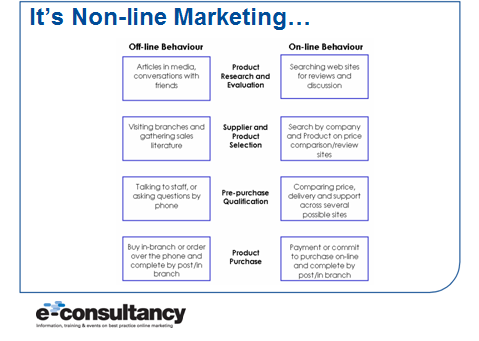
In our minds, and execution strategies, we typically live in the silos of On-line Marketing and Off-line Marketing. Sure we try to think, a little bit, of off-line when we do on-line and vice a versa. But in reality we live in a world where customers behave in a very weird way. Rather then choosing one channel over the other or starting at one and ending up at the other (as the linearity above might imply at first glance) our customers are going back and forth between the two channels depending on what stage they are in, what they are buying and what their comfort level is.
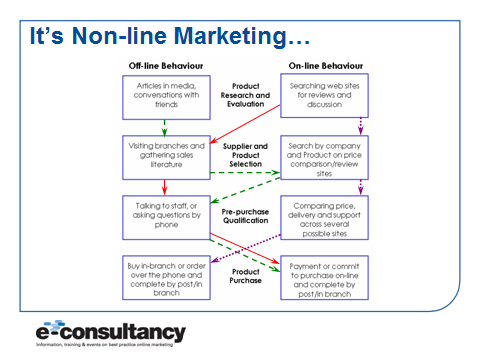
[I have taken the “artistic liberty” of illustrating three customer experiences on his slide, purely for communication purposes.]
We execute marketing programs and measure effectiveness as if the process is linear. But in reality as the red, green and purple lines indicate customer behavior is very different and we are not very well set-up to measure effectiveness. If you come to the website (the red line above), read reviews, go to the store, look and touch the products, talk to the sales person who totally wow’s you and you go and buy the product (all in one day). Who gets the credit? Your Google PPC program? What if your path was the one shown by the green arrows? Off-line then online then offline then online?
If the world truly is made up of non-line customer behavior should effectiveness of all our marketing programs be a “faith based initiative” (trust me my marketing is working, I just can’t prove it)? How can we measure success in a non-line customer experience world? Tough questions with evolving answers.
We are very much at the first baby steps of executing "nonline" marketing campaigns and measuring effectiveness of such campaigns. What is clear is that our customers already live in that world, we have to catchup. This is all the more reason that your core web success measurement strategy can't rest on the bedrock of clickstream data, if it was not already limiting before it is very much so now. Taking steps to incorporate other measurement sources such as surveys or remote usability or market research or collecting information via registration etc are going to be critical. And who knows that else is around the corner. [Qualitative data. Survey Best Practices.]
I want to thank Andy and David again for their wonderful presentations and also for sharing them with us.
[Like this post? For more posts like this please click here.]





 Via
Via 














Excellent summary Avinash, it is almost like being there. :) I have come to appreciate your perspectives very much.
The framing for Website Capabilities and Customer Expectations is brilliant, for most of us expectations are vastly different. I also now have a new buzzword to add: Nonline marketing (my company is certainly not ready for this and now I have common language I can present this concept to them).
Great post Avinash. Thanks for sharing!
I found your insights on the Carphone Warehouse views of customer acquisition of particular interest. I couldn't agree more that an assessment like the one that produced the graph shown would provide a great platform for showing an organization where to focus it's efforts.
Jaimie Scott
New forms of Engagment Metrics
Avinash Kaushik brought back some good stuff from London last week – bottled up in his latest post over at Occam's Razor.
1) Engagement metric – How is your site doing vs. Customer Expectations.
According to Avinash people now regularly expect "more" than what their website experience (on your site?) delivers…….
http://www.webmetricsguru.com/2006/11/new_forms_of_engagment_metrics.html
Hi Avinash,
I find really interestng the non-line presentation (I'll try to learn more about David Hughes and his company).
One thing that scared me at first, was when you were speaking about "faith based intiative'. I like to say that today's world is becoming more 'accountable' and that Web Analytics is a Best Practice towards that goal. And now that it seems that as the world is getting more complex, we might come back again to an 'obsurantist marketing' (Understand by obscurantist, the fact that marketeers said they had the science, but weren’t able to prove it) while we where aiming to a more scientific, measurable marketing…?
So we'll have to measure more complex situations.
Tough challenge, I agree with you ;-)
I just wanted to share with ou and your readers a case that recently won 2 'eficiency' IAB Awards here in Belgium (shameless plug I must admit as OX2 was the winner agency, hope you'll forgive me, you can view the case here). The case is about the integration of the offline and online channels (as the behaviours slide), in the fast food retail sector.
My guess is that the primary reason why we won the awards (best case + audience award) was because we were able to deliver some insights. Thanks to the fact that we tried to measure everything.
We delivered over 40.000 eCoupons and we found that it was a very interesting 'media'. eCoupons on the contrary of normal coupons can be very better tracked. In our case each eCoupon was unique and we had all the information about the user as his demographics, the shop in which he was planing exchanging the eCoupon, the referal (online and offline though a questionnaire), etc…
We could have gone further. With a good brain, a good Web Analytics tool with a Datawarehouse to integrate non web information, you could also link the buying behaviour of that person. As we provide the majority of loyalty cards through the internet it would be very esay to corelate the buying experience with the surfing experience and try to learn some common trends. But for that all data from shops need to be linked with the loyalty cards and then all that data needs to be collected and integrated.
It’s not just about buying a product and installing it’s about changing how things are done through the organization.
After having seen Visual Sciences I just can say that the future goes towards the complete integration of data. The only question is how long will it take until it becomes a comodity? ;-) As the visitor behaviour has evolved and more and more 'he's in charge' the only thing we can o is to use the best brains to figure out what are they trying to do and use methods and tools as surveys as you mention. This makes me also think about the Web 2.0 WA working group lead by Eric.
The future of Web Analytics will only get more complex altoguether:
On a technical level we're talking about more and more data collections and integrations; on the 'product' side we're talking about more and more product configurations as custom reports (I hope it won't become as complex as customizing SAP ;-)); and finaly the business side will need more and more skills to understand and still been able to think out of the box to define the right KPIs and deliver Insights and actionable reults.
Tough road ahead ;-)
Again, great concept non-line marketing.
Thanks for the post.
René
Rene: Shameless plugs are quite ok if they are accompanied by valuable comments / context and yours certainly had both of those attributes.
My reference to "faith based initiatives" was mostly as a challenge to current vendors and practitioners (web analytics or marketing).
We have barely begun to get our arms around online marketing and measuring its effectiveness. Yet the world we are measuring is dead and irrelevant, has been for a while (David started talking about nonline marketing two years ago), in terms of its ability to provide truly game changing insights.
This is something I have to figure out, how to react to that customer behavior, this is something you have to figure out, this is something we all have to figure out.
I might differ with you in terms of abilities and prospects of the current web analytics tools (all, including the four I actively use), even though they are getting increasingly sophisticated.
My bet is that real answers will not come from stuffing more data into traditional web analytics tools, they will come from the ability for web analytics tools to send data out in a very flexible and aggregated fashion. Mindsets, history, architectures, entrenchments are all challenges.
I do fully realize this is a controversial opinion and potentially a career limiting move on my part. :)
As always your comments and perspective are very thoughtful and very welcome. Thanks.
Avinash,
I am back! Great post – thanks for bringing a part of the conference back to us.
Both concepts lead to the key indicator – the rapid change in media usage. With convergent media usage being the direction of the now and future, what are your thoughts on multi-channel tracking and measurement?
I am aware of some companies that offer such tools/service, but is such analysis scaleable to a larger level?
Thoughts?
Sulu
Sulakshana: Welcome back, hope your new employer is all they are cracked up to be! :)
I have to admit that there are things relating to multi-channel, and hence nonline marketing, that are really hard to measure. But there are lots of interesting options emerging, from the url you see on circuit city receipts that asks for your feedback to redirects in campaigns to you being asked about your purchase during your product registration process to doing market research of existing customers to having continuous survey mechanisms on your websites and retail stores and phone channels.
All of these scale, they are not perfect but getting there.
Have to get to bed but I promise to write a post on multi channel and I'll welcome your feedback.
Thanks for the comment.
Thank you for the article. I have listed this as one of the top posts of the week at http://thoughtsonbusinessintelligence.blogspot.com/2006/12/articlesblogs-of-week-12292006.html
Thanks again. I'm enjoying your writing much.
Hi Avinash,
I´m working on a specific project for a client who is a famous brand of beer who is managing a very successful loyalty program. The buyers could enter the pin codes they get inside the beer package in supermarkets (off line)and change it for products from an on line catalog. So that, how can we introduce the non line marketing concept when we sell products with not so much decision process as beer it is?
thanks and congratulations for your posts
Hi Avinash,
You make a good point on the importance of quantifying the value and volume of personas. It's something that needs to be given more importance than what it has been getting. This really is food for thought on how we use personas when working on websites…
Does anyone have case studies or documentation to share on the subject?